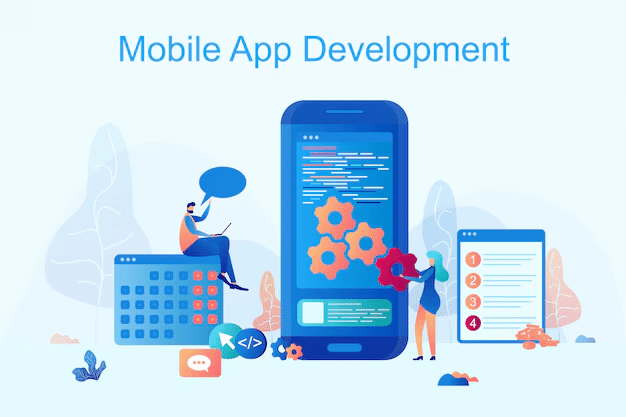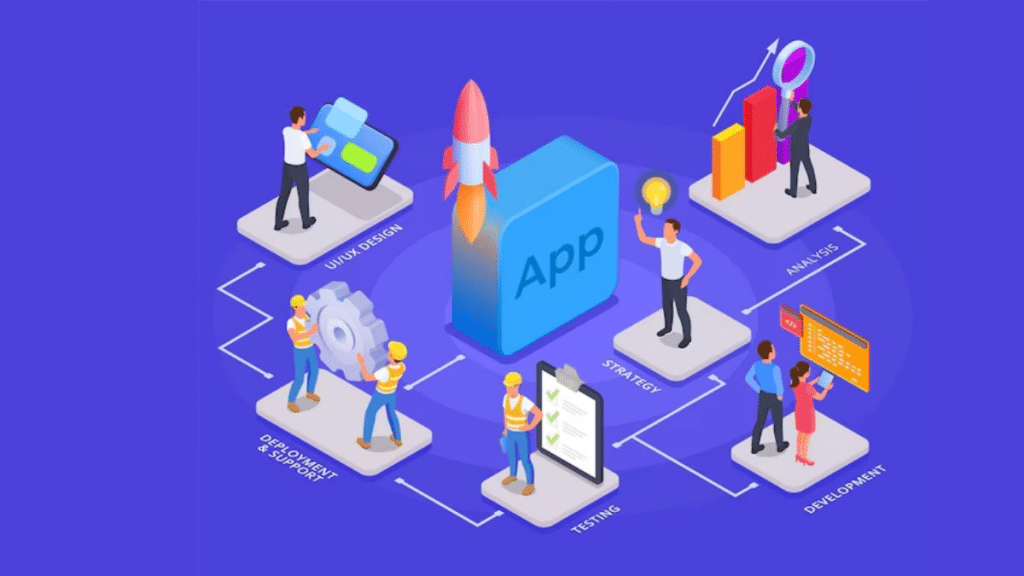Do you see any mobile applications or websites without AI chatbots these days or do you see eCommerce products not chasing you everywhere online? I think your answer is ‘NO’.
Building a dream app is no longer the same as 5 years back. Now, a powerful mobile app development requires AI, AR, IoT, VR, and many other latest technologies to build competitive features and user-friendly designs. Our Real Estate app development company has built many apps so far and realized that the app market is changing exponentially.
When I talked to the developers who have used emerging technologies for building mobile applications, I found a common transformative potential the latest technologies bring to the user experience. The developers emphasize the seamless integration of innovative features.
Over 5 billion people in the world use mobile applications every day. They use the apps for various tasks ranging from ordering food, buying clothes, tracking fitness, talking to people, searching for soulmates, traveling, and so on. Mobile apps have a global impact and generate good revenue ($346 billion in 2022) therefore more people want to have mobile apps for their businesses.
In this blog, we will learn about the process of mobile app development. So that you can build your dream app effectively and enable the smooth running of your business.
Without further ado let’s get started!
Why is building a mobile app beneficial for a business?
With a mobile app, you can reach people living in any corner of the world and that is with just a few clicks. Explore the array of benefits of having a mobile app for a business below.
1. Increased accessibility:
Mobile apps provide users with easy and quick access to your business at any time, anywhere, helping in engagement and customer interaction. Whoever has a smartphone and access to the internet can become your customer. You only have to find your target audience
2. Enhanced customer engagement:
Apps enable personalized interactions and send real-time notifications, and promotions to keep customers informed and engaged. They provide various services on a single app. For example, people can use a travel app for various services like restaurant booking, checking locations, flight tickets, and more. It improves customer engagement with the business. Hire a travel app development company after checking its previous projects, if you also want a travel app.
3. Brand visibility and recognition:
The presence of your app in the user’s phone indicates that the user knows your brand and trusts it. A dedicated mobile app for your business leads to brand recognition and ensures your business stays top of mind.
4. Improved customer loyalty:
You can run loyalty programs, exclusive deals, and personalized content on your app. It encourages customer retention and fosters a sense of loyalty towards a brand. Having a dedicated brand of a company improves credibility as well.
5. Streamlined communication:
Mobile apps provide a direct communication channel between businesses and users. It enables efficient support, and feedback, and addresses customer queries quickly.
6. Data collection and analytics:
Businesses can gather valuable user data to understand the buying patterns of the people on their apps. It helps businesses to make target marketing strategies according to customer data.
7. Increased sales and revenue:
Customers can make other purchases also related to the service and product they want to buy on the app. It contributes to increased sales and revenue.
8. Global reach:
Mobile apps open up opportunities for global expansion. Mobile applications allow businesses to reach a wider audience and find new markets beyond geographical limitations.
9. Enhanced user experience:
Mobile apps are designed for specific features of smartphones, providing a seamless and optimized user experience. Using mobile apps is better than responsive websites on the browser.
Key phases of mobile app development

The number of total phases of mobile app development varies depending on the type and requirement of the app. But some phases are common and all types of app development procedures include them.
1. Planning
2. Design
3. Development
4. Testing
5. Deployment
6. Post-launch support
7. Marketing and promotion
8. Analysis and optimization
Learn about each phase in the detail below.
1. Planning:
Planning is an initial phase as an entire development process moves forward according to it. Planning helps in making informed decisions. The first step is to clearly define the app’s purpose, which means answering the question “Why is the app being created?”. It involves understanding the specific problems the app will resolve.
Identifying a target audience is also crucial as you have to plan the app in a way that will solve their problems. When you know who will use the app, customizing its features and designs becomes easy. Before planning, conduct thorough market research and collect all the information.
Competitor analysis is also part of the research as it helps to create a competitive app. Overall collect all the necessary information so that you can plan app development effectively.
2. Design:
The design phase is about creating a blueprint of an application. It indicates how the app will look and feel. Many front-end tools are used for creating the UI and UX designs of the app. It is a static app development without any functionalities. Before the actual coding for app design two important steps occur.
One is wireframing and the second is prototyping. Wireframing is like a skeleton of the app with an outline of its structure and basic functionalities. Conversely, a prototype is an interactive model of the app. It allows stakeholders to visualize how the app will function.
In this phase, designers integrate visual elements like buttons, layout, and others. They have to ensure that the elements are aesthetically pleasing and intuitive.
3. Development:
After the static part, which means designing, now comes the functional part. It is time to add functionalities to the features designers have built. So, conceptualized designs take tangible form. Developers code to add functions to UI and UX designs. PHP is used for backend development. Select the best PHP development company for your app’s server-side development.
Additionally, integration with the Application Programming Interface is executed for seamless interaction. Back-end development takes place in this phase. Developers use tools and frameworks for server-side development and Laravel is one of them. A Laravel development company ensures smooth and quick integration of third parties on the app for better user experience.
This is the longest phase of mobile app development because developers have to build logic for unique functionalities. It includes building features from scratch, specifically innovative ones as frameworks provide prebuilt features for common ones.
4. Testing:
Conduct thorough testing to ensure the app functions correctly on various devices and operating systems. You have to test an application for different performance criteria like security, user interface, page load, bugs, and errors. Gather feedback through beta testing to address user concerns.
Functional testing verifies that each feature operates as intended. Performance testing checks the app’s responsiveness and speed under different conditions. Whereas, security testing verifies authenticity and checks vulnerabilities. Compatibility testing ensures the app functions seamlessly on different devices.
Moreover, user acceptance testing involves how smoothly it is to navigate the app for users. Testing is not the end process, it is continuous through the process of app development. So comprehensive testing is important for delivering high-quality apps.
5. Deployment:
The deployment phase brings the mobile app to its intended audience. It involves publishing the app on platforms like Apple App Store or Google Play Store. You have to stick to the guidelines of the particular platform before submitting the app on it. Submitting the app considering guidelines ensures smooth and successful submission.
This way, you can meet the technical and content requirements specified by the app stores. Once the app is approved, it is available for download. Now you have to promote an app through various channels such as email campaigns, social media, and partnerships to increase the app’s visibility and downloads.
A real estate software development company does everything for stakeholders, from planning, designing, development, and testing to deployment. So, you can seek the help of a top mobile app development firm for the same.
6. Post-launch support:
Post-launch support is related to ongoing assistance and maintenance provided to an app after the completion of its development. It is important to address unexpected issues, errors, bugs, updates, and trends. Bug fixing means addressing issues and bugs that users encounter while using the app.
Developers resolve these issues quickly before more users encounter them or know about them. To keep the app fresh and trendy, release new features and improvements. Regularly track the app’s performance to find issues on time and resolve them.
If you want an app for the Android platform, hire an Android app development company as many firms provide post-launch support. But before hiring confirm whether the company offers this service or not.
7. Marketing and promotion:
A comprehensive marketing strategy helps to make loyal customers. Talk about your services and features in marketing campaigns. Use different platforms for marketing as not all people use a particular platform. Post regularly about the app to improve credibility.
As you are done deciding on your target audience, creating marketing strategies becomes easy. Analyze customers’ buying patterns and other details with data analysis so that you can save time and money with effective and successful app marketing.
Many Travel website development services providers use impressive marketing techniques to attract customers. They post about beautiful destinations and how their app helps to reach there. It improves the app’s visibility which is most important to increase customers.
8. Analysis and optimization:
Analytics tools help to analyze the performance of the app. These tools assist you in learning about user conversion rates, behavior, and engagement. If you don’t focus on analyzing users, then you can lose traffic and even loyal customers as well. They will find other apps providing personalized services.
Optimize the app based on data insights and user feedback. Knowing minute details regarding how customers select services, what they like to buy, and how they buy helps to make effective decisions.
The main challenges in developing a mobile application

Developing a mobile app comes with a set of challenges. Knowing these challenges defines how to start app development smartly so that you don’t have to struggle much.
- Adapting the app to various platforms
- Designing engaging features
- Optimizing performance
- Security concerns
- Integrating with third-party services
- Testing across devices
- Continuous updates and maintenance
- Market saturation and visibility
- Managing user feedback
- Budget constraints
- Legal and compliance issues
Conclusion
App development is a long process and involves many challenges as well. Professional developers can make it easy for you. Now tools like ChatGPT are available to make the work of developers easy. However, putting the best foot forward is crucial for a successful app. So, learn about why a mobile app is important for a business and how to build it effectively in the blog. Follow the steps mentioned along with possible challenges so that you can avoid big mistakes easily. Talk to experts of app development like Technource for genuine advice and right strategy.

